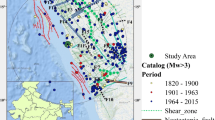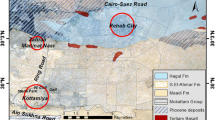Abstract
The objective of the study is to understand the seismicity of the Western coast and its adjoining regions whose seismic potential has not been evaluated so far. The study area encompasses a major portion of Karnataka and Northern part of Kerala and Goa. The approach incorporated in the study is probabilistic in nature and attempts to capture the uncertainty involved in various phases of hazard estimation. The seismic sources in the study region are mostly diffused in nature and are modeled as areal sources with uniform seismicity within a source zone. Regionally, adaptable ground motion prediction equation constitutes the ground motion modeling. The epistemic uncertainty involved in the selection of ground motion models is addressed by adopting a logic tree approach. The seismic source model and the ground motion model are combined together to produce hazard curves for the study region. Most of the ground motion prediction equations are developed for hard rock conditions (Vs > 800 ms−1). However, most of the built environment rests on the soil and there is a necessity to estimate the hazard values at the surface level. Based on the site topography, it was observed that majority of the study area belongs to NEHRP site class C and D. The hazard values were estimated for the boundary site condition CD (310 < VS (30) < 520 ms−1) using a nonlinear site amplification model. Seismic hazard maps produced from this study are believed to be of immense use for building planners and designers.
Access this chapter
Tax calculation will be finalised at checkout
Purchases are for personal use only
Similar content being viewed by others
References
Cornell CA (1968) Engineering seismic risk analysis. Bull Seismol Soc Am 58:1583–1606
Khattri KN, Rogers AM, Perkins DM, Algermissen ST (1984) A seismic hazard map of India and adjacent areas. Tectonophysics 108(1–2):93111–108134
Bhatia SC, Kumar MR, Gupta HK (1999) A probabilistic seismic hazard map of India and adjoining regions. Ann Geophys 42(6)
Iyengar RN, Ghosh S (2004) Microzonation of earthquake hazard in greater Delhi area. Curr Sci 87(9):1193–1202
Chopra S, Kumar D, Rastogi BK, Choudhury P, Yadav RBS (2013) Estimation of seismic hazard in Gujarat region. India Nat Hazards 65(2):1157–1178
Das R, Sharma ML, Wason HR (2016) Probabilistic seismic hazard assessment for northeast India region. Pure appl Geophys 173(8):2653–2670
Maiti SK, Nath SK, Adhikari MD, Srivastava N, Sengupta P, Gupta AK (2017) Probabilistic seismic hazard model of West Bengal. India J of Earthq Eng 21(7):1113–1157
Subrahmanya KR (1996) Active intraplate deformation in south India. Tectonophysics 262(1–4):231–241
Dasgupta S, Narula PL, Acharyya SK, Banerjee J (2000) Seismotectonic Atlas of India and its environs. Geological Survey of India
Oldham TA (1883) Catalogue of Indian Earthquakes from the earliest time to the end of AD 1869, Memoirs of the Geological Survey of India 19 Part 3
Chandra U (1977) Earthquakes of peninsular India—a seismotectonic study. Bull Seismol Soc Am 67(5):1387–1413
Rao BR, Rao PS (1984) Historical seismicity of peninsular India. Bull Seismol Soc Am 74(6):2519–2533
Martin S, Szeliga W (2010) A catalog of felt intensity data for 570 earthquakes in India from 1636 to 2009. Bull Seismol Soc Am 100(2):562–569
Rastogi BK (2016) Seismicity of Indian stable continental region. J Earthq Sci Eng 3:57–93
Kolathayar S, Sitharam TG, Vipin KS (2012) Spatial variation of seismicity parameters across India and adjoining areas. Nat Hazards 60:1365. https://doi.org/10.1007/s11069-011-9898-1
Musson RM, Grünthal G, Stucchi M (2010) The comparison of macroseismic intensity scales. J Seismolog 14(2):413–428
Gardner JK, Knopoff L (1974) Is the sequence of earthquakes in Southern California, with aftershocks removed, Poissonian? Bull Seismol Soc Am 64(5):1363–1367
Stepp JC (1973) Analysis of completeness of the earthquake sample in the Puget Sound area. Seismic zoning edited by ST Harding NOAA Tech. Report ERL
Gutenberg B, Richter CF (1944) Frequency of earthquakes in California. Bull Seismol Soc Am 34(4):185–188
Aki K (1965) Maximum likelihood estimate of b in the formula logN = a−bM and its confidence limits
Kijko A, Smit A (2012) Extension of the Aki-Utsu b-value estimator for incomplete catalogues. Bull Seismol Soc Am 102(3):1283–1287
Shreyasvi C, Venkataramana K, Chopra S, Rout MM (2019) Probabilistic seismic hazard assessment of Mangalore and its adjoining regions, a part of Indian Peninsular: an intraplate region. Pure Appl Geophys 176(6):2263–2297
Cramer CH, Kumar A (2003) 2001 Bhuj, India, earthquake engineering seismoscope recordings and Eastern North America ground-motion attenuation relations. Bull Seismol Soc Am 93(3):1390–1394
Atkinson GM, Boore DM (2006) Earthquake ground-motion prediction equations for eastern North America. Bull Seismol Soc Am 96(6):2181–2205
Campbell KW (2003) Prediction of strong ground motion using the hybrid empirical method and its use in the development of ground-motion (attenuation) relations in eastern North America. Bull Seismol Soc Am 93(3):1012–1033
Iyengar RN, Chadha RK, Balaji Rao K, Raghukanth STG (2010) Development of probabilistic seismic hazard map of India. The National Disaster Management Authority, 86
Toro GR (2002) Modification of the Toro et al. (1997) attenuation equations for large magnitudes and short distances. Risk Engineering Technical Report
Bommer JJ, Douglas J, Scherbaum F, Cotton F, Bungum H, Fäh D (2010) On the selection of ground-motion prediction equations for seismic hazard analysis. Seismol Res Lett 81(5):783–793
Danciu L, Kale Ö, Akkar S (2016) The 2014 earthquake model of the Middle East: ground motion model and uncertainties. Bull Earthq Eng 1–37
Aguilar-Meléndez A, Schroeder MGO, De la Puente J, González-Rocha SN, Rodriguez-Lozoya HE, Córdova-Ceballos A, Campos-Rios A (2017) Development and validation of software CRISIS to perform probabilistic seismic hazard assessment with emphasis on the recent CRISIS2015. Computación y Sistemas 21(1):67–90
Choi Y, Stewart JP (2005) Nonlinear site amplification as function of 30 m shear wave velocity. Earthq Spectra 21(1):1–30
Jaiswal K, Sinha R (2007) Probabilistic seismic hazard estimation for peninsular India. Bull Seismol Soc Am 97(1B):318–330
Kolathayar S, Sitharam TG (2012) Characterization of regional seismic source zones in and around India. Seismol Res Lett 83(1):77–85
Ashish Lindholm C, Parvez IA, Kühn D (2016) Probabilistic earthquake hazard assessment for peninsular India. J Seismolog 20(2):629–653. https://doi.org/10.1007/s10950-015-9548-2
Sitharam TG, James N, Vipin KS, Raj KG (2012) A study on seismicity and seismic hazard for Karnataka State. J Earth Syst Sci 1–16
Nath SK, Thingbaijam KKS (2012) Probabilistic seismic hazard assessment of India. Seismol Res Lett 83(1):135–149
Sitharam TG, Kolathayar S (2013) Seismic hazard analysis of India using areal sources. J Asian Earth Sci 62:647–653
Amateur Seismic Centre, http//www.asc-india.org/, Pune, India (last accessed 31st March 2017)
Incorporated Research Institutions for Seismology, Earthquake browser, http //www.iris.edu/hq/ (last accessed 26th October 2016)
Indian Meteorological Department (IMD), www.imd.gov.in/, New Delhi, India (Through Personal communication)
International Seismological Centre, Online Bulletin, http //www.isc.ac.UK, Internatl. Seismol. Cent., Thatcham, United Kingdom, 2014 (last accessed on 31st October 2016)
IS1893(Part 1)- 2016, Indian standard, criteria for earthquake resistant design of structures, sixth revision, Part-I. Bureau of Indian Standards, New Delhi
National Earthquake Information Center 2003 USA PDE reportingshttp //neic.usgs.gov/neis/epic/ (last accessed on 28th November 2016)
Author information
Authors and Affiliations
Corresponding author
Editor information
Editors and Affiliations
Rights and permissions
Copyright information
© 2020 Springer Nature Singapore Pte Ltd.
About this paper
Cite this paper
Shreyasvi, C., Venkataramana, K. (2020). Seismic Hazard Estimation for Southwest India. In: Prashant, A., Sachan, A., Desai, C. (eds) Advances in Computer Methods and Geomechanics . Lecture Notes in Civil Engineering, vol 56. Springer, Singapore. https://doi.org/10.1007/978-981-15-0890-5_18
Download citation
DOI: https://doi.org/10.1007/978-981-15-0890-5_18
Published:
Publisher Name: Springer, Singapore
Print ISBN: 978-981-15-0889-9
Online ISBN: 978-981-15-0890-5
eBook Packages: EngineeringEngineering (R0)




